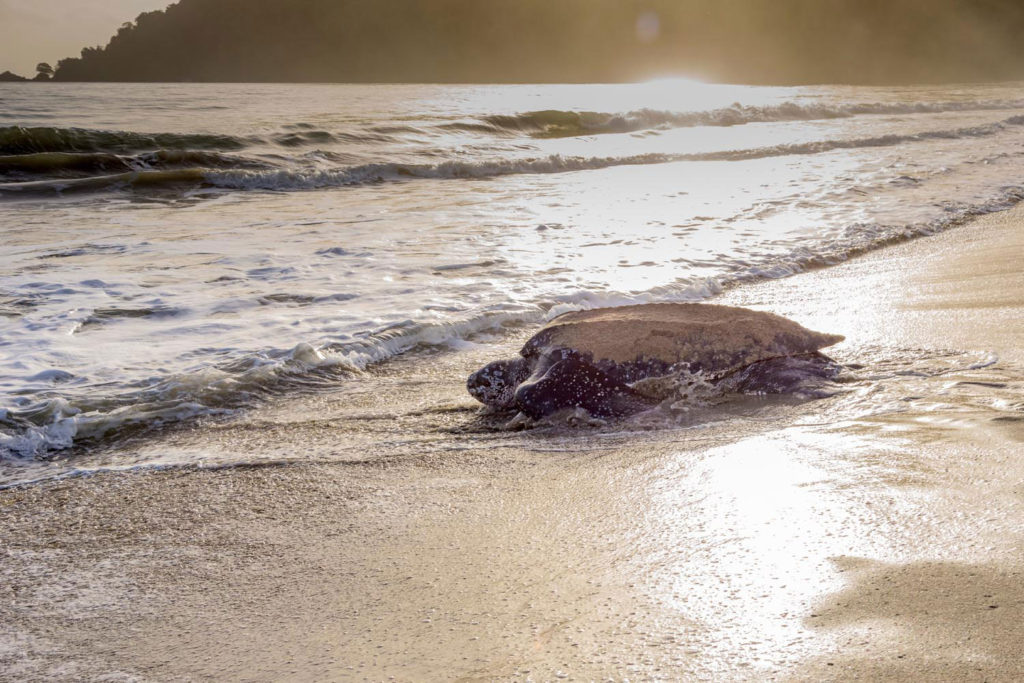Learn about the best places to see leatherbacks, hawksbills, greens, olive ridleys, and loggerheads across the region — and some of the community organisations working to save them
The return of the ancient mariners
The Caribbean is among the most important turtle nesting grounds globally — particularly Trinidad, which is the second largest nesting site for leatherback turtles in the world, and the largest in the western hemisphere. And May through August is the best time to see both the nesting mothers and the baby hatchlings who begin to emerge during these months. It’s a magical, unforgettable experience.
Sea turtles are one of the planet’s keystone species, and play important roles in keeping our oceans healthy. They provide food for other species, maintain coral reefs and seagrass beds as well as control jellyfish populations.
It’s one of the many reasons WIDECAST — the Wider Caribbean Sea Turtle Network comprising NGOs across the Caribbean (www.widecast.org) – has worked tirelessly to protect them, through a range of community-driven programmes, beach patrols, turtle-tagging, captive breeding, rehabilitation, public education, and turtle tours for locals and visitors alike.
Trinidad & Tobago
T&T is home to five sea turtle species (leatherbacks, hawksbills, greens, olive ridleys, and loggerheads), and sees large numbers of turtles on five beaches in particular: Grand Rivière, Matura, Fishing Pond (in Trinidad) and Stonehaven and Courland (Tobago). Turtles also nest on a number of other beaches around both islands, including many popular ones like Maracas, Las Cuevas, Mayaro, Manzanilla, Lambeau, Man O’ War Bay, and Pigeon Point.
Leatherbacks are the main attraction at this time of year, especially in Trinidad. From March to August, thousands of leatherbacks make their way back to the beaches on which they were born, hauling themselves up on to the shore — usually under the cover of darkness — then painstakingly digging holes in the sand into which nesting mothers may deposit up to around 100 eggs each time they nest. Once finished, they will backfill the nests with a thick layer of sand and return to the ocean. They often nest more than once during the season.
Roughly two months later, little heads will emerge from the sand as hatchlings make a dash for the ocean. They face long odds — about one in 1,000 will reach maturity. The females that do will eventually make their way back to these shores to begin the ritual anew.
To arrange for a turtle tour, contact Nature Seekers, SOS Tobago, or any of the NGOs who form part of the Turtle Village Trust: (868) 667-8471, turtlevillagetrust.org. Their invaluable work has made T&T’s conservation programmes among the most successful in the world.
Guyana
Guyana’s Shell Beach on the northern coast is a prime spot to see one of the ocean’s smallest sea turtles: the olive ridley. More common in waters around South America than up the island chain, olive ridleys can nest up to three times per season (March–August), laying more than 100 eggs each time. To experience this miracle of life, be prepared to make a bit of a journey across multiple modes of transportation to get there. The Guyana Marine Turtle Conservation Society organises tours: (592) 600-7272, www.guyanamarineconservation.org.
Barbados
Barbados prides itself on being home to one of the Caribbean’s largest hawksbill populations. Nesting mothers — who tend to seek out more isolated areas to nest on the south and west coasts of the island — return to the same beach in Barbados every few years between April and November. They can lay over 100 eggs at a time, and up to six times a season. For more, contact the Barbados Sea Turtle Project: (246) 230-0142 and barbadosseaturtles.org, or via social media.
The Cayman Islands
The Cayman Islands’ national symbol is the green turtle. However, populations had been almost completely decimated several years ago, primarily because of human activity. Luckily, efforts of NGOs have significantly improved the situation — nesting numbers have increased, and a combination of advocacy and protective measures has kept populations stable. Green turtles lay eggs more than once per season and each nest can hold more than 100. For tours, contact the Cayman Islands Turtle Centre: (345) 949-3894, info@turtle.ky.
Around the region…
Grenada: loggerheads, greens, hawksbills, and notably leatherbacks visit the island, particularly Levera Beach, from April to June. www.oceanspirits.org
Dominica: spy loggerheads, greens, leatherbacks, and especially hawksbills, particularly at Rosalie Bay, Bout Sable, Cabana Bay, Wesley, and Calibishie from April to June. www.DomSeTCO.org
Jamaica: hawksbills are the main attraction here, especially on the north coast from June through August. www.jamentrust.org/sea-turtles
Florida (USA): loggerheads and four other species are protected by the Florida Fish and Wildlife Conservation Commission’s Marine Turtle programme, with great turtle-watching opportunities on the east coast (between Titusville and Fort Lauderdale), especially in June and July. myfwc.com/research/wildlife/sea-turtles

